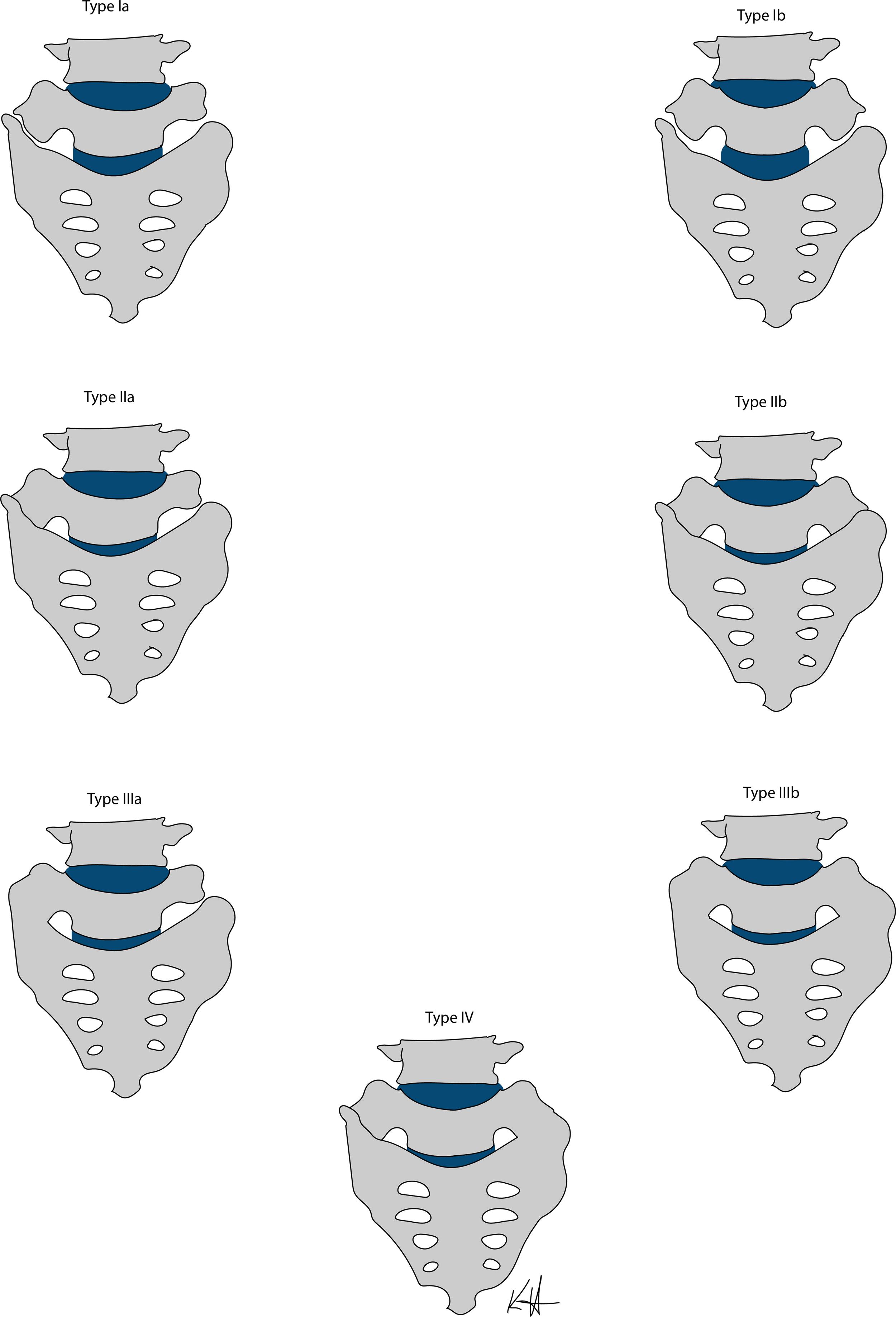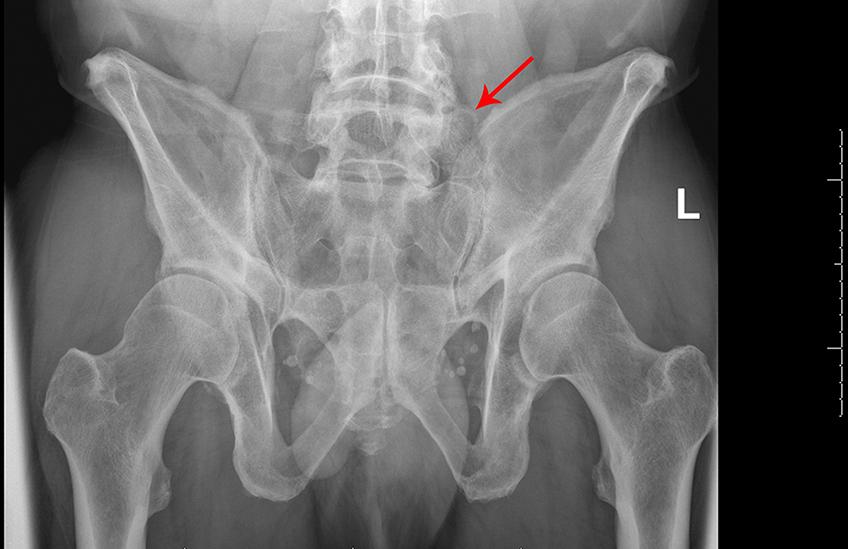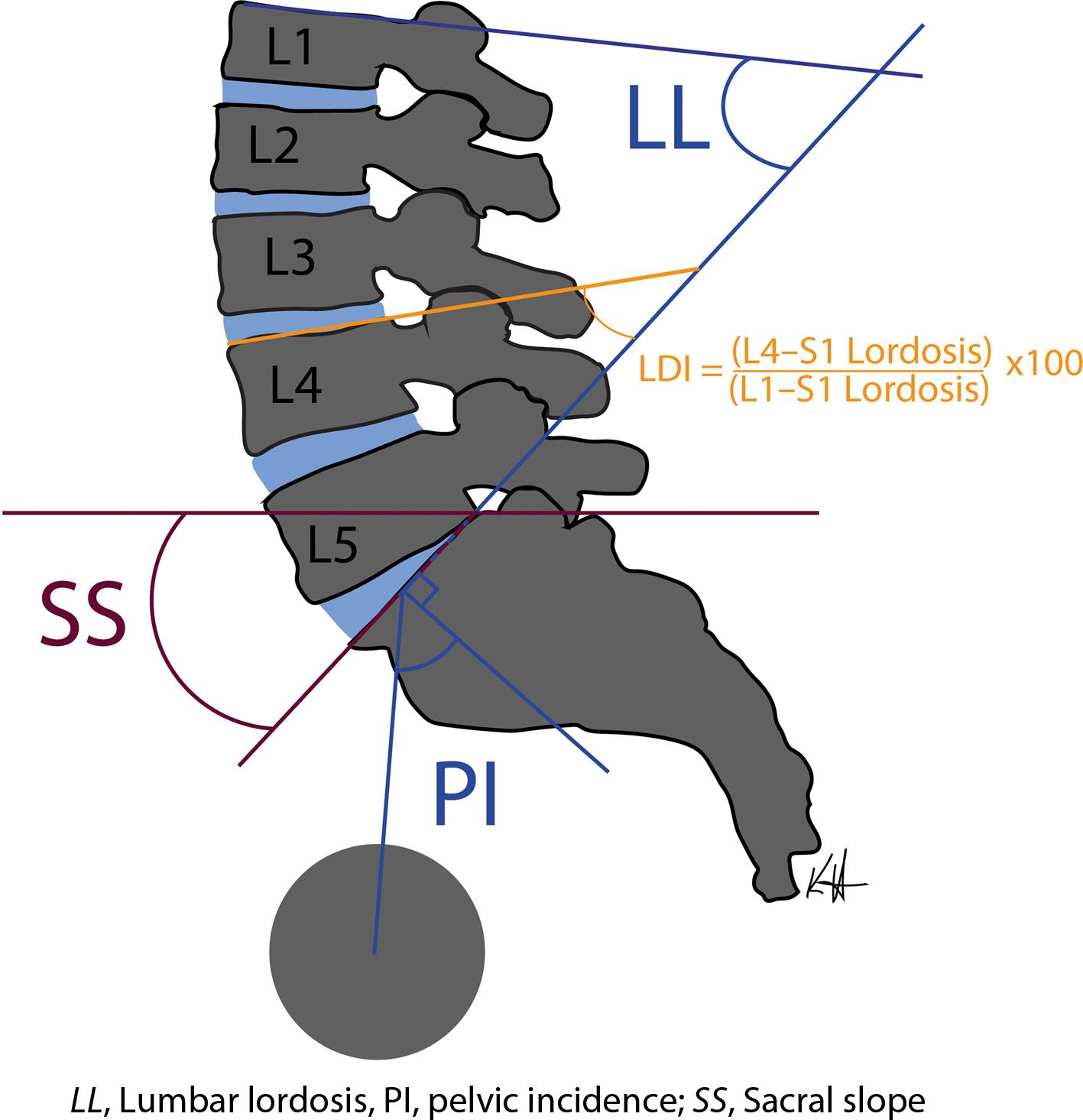Physical Address
304 North Cardinal St.
Dorchester Center, MA 02124
The typical vertebral column is composed of 33 vertebrae. The lumbar spine usually has five mobile lumbar vertebrae, denoted as L1–L5. As a group, the lumbar vertebrae create a lordotic curve. The vertebral bodies increase in size as the spinal column descends, because of the increasing demands of load bearing. The lumbar vertebrae have distinct features that make them discernible from the cervical and thoracic vertebrae. Most notable are the large vertebral bodies, which consist of cancellous bone surrounded by cortical bone. These bodies are wider transversely than they are deep anteroposteriorly. They also develop into a wedge shape as they descend the column, with the L5 vertebra having the greatest difference between anterior and posterior height. This difference creates the lumbosacral angle. The pedicles are short and thick, arising from the upper third of the body. The transverse processes are thin, long, and flat in the anteroposterior (AP) plane. The articular processes are vertical and large with a rounded enlargement on the posterior border, known as the mammillary process. The superior facets face posteromedially with a somewhat concave surface. The inferior facets project downward and face largely laterally and anteriorly in concordance with the superior facets, with a slightly convex articulating surface. The inferior facet of the L5 vertebrae differs by having a flat articulating surface that faces largely anteriorly. The spinous processes are short and broad and project perpendicularly from the body.
The typical lumbar spine has five lumbar vertebrae, but up to 10% to 15% of the population is recognized with an anatomical variant known as a lumbosacral transitional vertebra. The optimal method of classifying transitional segments was outlined by Castellvi in 1984. Castellvi described a classification system using radiographic imaging, identifying four groups of lumbosacral transitional vertebrae based on their morphological characteristics ( Fig. 1.1 ). Type I includes a dysplastic transverse process, either unilateral (Ia) or bilateral (Ib), presenting as triangular in shape, and measuring at least 19 mm in width. Type II exhibits incomplete lumbarization/sacralization, either unilateral (IIa) ( Fig. 1.2 ) or bilateral (IIb), with a large transverse process that follows the contour of the sacral ala. These are recognized as incomplete by the appearance of a diarthrodial joint between the transverse process and the sacrum. Type II is most consistently associated with lower back and buttock pain. Type III describes complete lumbarization/sacralization, either unilateral (IIIa) or bilateral (IIIb), in which the transverse process has made complete fusion to the sacrum. Type IV is mixed, with these patients exhibiting characteristics of type II on one side and type III on the other. This system is useful in classifying the morphology of the transitional segments, but it does not provide enough accurate information for numbering the involved segments.


Lumbar spine alignment is dependent upon the pelvic incidence (PI). The PI is a parameter that assesses the depth of the femoral head to the midpoint of the sacral endplate. First described in 1992 by Madam Duval-Beaupère, the concept of PI has been used extensively since that time. We have learned over the decades that PI drives the lumbar lordosis (LL). The LL should be no more than 9 degrees greater or less than the PI. Perhaps this is slightly more complex, and patients with low PI should probably have a LL of PI plus 9 degrees and those with a high PI should probably have a LL of PI minus 9 degrees. Also of importance is the distribution of lordosis along the lumbar vertebrae. This is called the LL distribution index, which indicates that approximately two-thirds of the lordosis should be located from L4 to S1. This has been further developed by Roussouly et al., who looked at the overall sagittal alignment of the lumbar spine, not only focusing on the LL and the PI but also considering the sacral slope. They highlighted the importance of the sacral slope and lower lumbar curve in determining the global lordosis and sagittal alignment of the spine. These lumbar angles of interest can be seen in Fig. 1.3 .

Under normal physiological conditions, axial spine load transmission should be homogenous across intervertebral segments. It has been shown, with a high degree of specificity, that some forms of low back pain correlate with abnormal load transmission across vertebral bodies. During spinal fusion, the primary goal is to provide a solid and uniform bony mass across a segment that allows for stable load transmission. By the same token, failure to restore physiological stress patterns of load transmission across intervertebral segments during spine fusion has been hypothesized as explaining why some patients remain symptomatic despite evident fusion.
Balanced load transmission is important to ensure construct stability and avoid graft subsidence. Closkey’s work on load transmission in fusions showed that approximately 30% cross-sectional area during interbody fusion is needed to handle adequate load transmission across an intervertebral space. Below this number the pressure point on the caudal vertebra is too high and the graft can subside through the superior aspect of the vertebra, leading to motion and poor stability, and is associated with a higher risk of pseudarthrosis. Closkey’s findings are most relevant in anterior fusions where graft material is under direct axial load compression, and adequate cross-sectional area facilitates load transmission and solid fusion. This has not been well recognized by many surgeons and as a result inadequate spot-welds often exist that are incapable of transmitting the load. Load transmission differs in posterior fusions; loads are transmitted by cantilever forces, which require more robust bone cross-sectional area to support a similar load.
Not uncommonly, treatment for spine pathology requires a fusion. Multiple approaches have been developed over time that best tailor the patient's needs. These can be roughly divided into anterior and posterior approaches, each of them with their particular advantages and disadvantages. Spine surgeons use and combine techniques as necessary to best treat the pathology at hand.
The three ways to approach the spine anteriorly are direct anterior, oblique, and lateral. They all provide excellent access to the disc space and end-plate preparation, and, if necessary, allow placement of implants with large footprints that minimize the risk of subsidence. More importantly, we know from biomechanical studies that the anterior and middle columns carry about 80% of spinal loads. When taking this into consideration along with Wolff’s law of bone remodeling in response to applied stress, a fusion mass has better potential for healing if placed anteriorly, where it is under direct compression. Not only is an anterior fusion under direct compression, but the anterior and middle column provide 90% of osseous contact between vertebrae, as well as a more vascular bed. Distraction with a large interbody implant provides better neuroforaminal decompression. Additionally, it can be very powerful in deformity correction in the coronal and sagittal planes. These approaches are not suitable for patients that have central canal stenosis, bony lateral recess stenosis, or high-grade spondylosis.
Direct anterior: In the direct anterior approach, the patient is positioned supine and this is followed by a median, paramedian, or mini-Pfannenstiel incision. This provides a retroperitoneal corridor with direct access to the disc space. Presurgical advanced imaging is necessary, as it will determine the limitations imposed by visceral structures. Most often, the direct anterior approach is used to access the L4–L5 and L5–S1 disc spaces, with higher levels limited by the degree of retraction on the vascular and renal structures. There are drawbacks associated with this approach such need for an access surgeon, risk of vascular injury, and the possibility of retrograde ejaculation secondary to injury to the hypogastric plexus. Previous abdominal surgeries are not an absolute contraindication to this approach, but should be taken into consideration as they might make the exposure more difficult. Placement of a ureteral stent can aid in the approach, and with a skilled approach, revision anterior surgery can be done.
Oblique: For the oblique approach to the anterior spine, the patient is placed in a lateral decubitus position. Along the flank, the surgical corridor is between the retroperitoneum and the psoas muscle. This approach does not require retraction of vascular structures or violation of the psoas muscle. As such, the levels accessible to this approach are from L1 to S1. Although vascular structures are not manipulated directly, they are still at risk given their proximity with the surgical field. The risk of retrograde ejaculation is still present. Because the approach involves dissection through the abdominal musculature, patients can develop hernias or pseudohernias secondary to denervation of the flank musculature. Furthermore, the approach requires experience to adequately assess its obliquity without inadvertent entry into the canal or violation of the lateral annulus. Clinical experience suggests that this is more technically challenging than the standard straight anterior approach and to date no current data is available on revision oblique approaches.
Lateral: The patient is placed in the lateral decubitus position. For this approach, the surgical corridor is retroperitoneal but transpsoas. The disc spaces accessible through this approach are T12–L1 to L4–L5. Preoperative images need to be obtained to determine if the planned region of the lumbar spine can be accessed through this corridor, with particular attention to the relationship between the top of the iliac crest and the level to be accessed. Care must be taken at the L4–L5 level to avoid injuring the femoral nerve. This approach allows bilateral access to the lumbar spine, which is advantageous for coronal plane deformity correction, as it is better managed from the convex side. The lumbar plexus is at risk during a transpsoas approach, its position drifting more anteriorly with more-caudal levels. About 5% of patients complain of sensorimotor disturbances post surgically. Because the approach is to the lateral abdominal musculature, the possibility of hernia and pseudohernia are also present, but are minimized with careful dissection to prevent denervation. This approach allows resection of the disc transversely all the way across, but the risks of this are contralateral vessel or visceral injury.
Posterior: For this approach, the patient is positioned prone, which is followed by a midline approach. The fusion procedure involves decortication of the lamina, with or without the spinous processes, and typically involves the facet joints. This fusion mass is in the least advantageous position biomechanically, as it must support all the loading via a cantilever loading technique, thus experiencing minimal compression compared with its anterior counterpart. Even with a solid posterior fusion, there have been instances of persistent anterior column pain demonstrated by discography and later confirmed by clinical improvement after anterior interbody fusion. Although this fusion has long been the workhorse of the available surgical techniques, it is not without its problems. Revision surgery through a posterior approach is common. The main increased risks from this are bleeding of the scar bed, distorted landmarks depending on the prior intervention, and possible incidental durotomy in patients with significant laminectomy defects.
Posterolateral: The posterolateral fusion is the more commonly used posterior approach and involves not only the lamina and facet, but also the transverse processes. This puts the axis of loading closer to the fusion mass and in a more biomechanically advantageous position. A drawback of this technique is that it requires more stripping of the muscles to gain access to the grafting area. A variation of this is the paraspinal or Wiltse-type approach. This variation provides similar access with less muscle disruption and for many years was a mainstay for fusion in young adults with spondylolysis. It has also been used in a minimally invasive fashion as a way of accessing the paraspinal or Wiltse plane. However, more typically, the minimally invasive approaches have involved a transforaminal lumbar interbody fusion.
A number of techniques over the years have used this method of obtaining interbody fusion. It began with the posterior lumbar interbody fusion, which involves significant lamina resection and side-to-side dural mobilization to access the disc space and place bone graft into this area. The next advancement was the so-called transforaminal lumbar interbody fusion, which was originally described as a single-sided approach that allowed cleaning out of approximately two-thirds of the disc space and obtained an interbody fusion with bone graft and/or structural interbody support. These techniques use a working window in which the thecal sac and traversing nerve root form the medial border and the exiting nerve root of the proximal vertebra forms the lateral border. This technique has subsequently been a workhorse approach when done bilaterally and combined with Smith-Peterson osteotomy for both extensive disc clean-out and bone grafting structural interbody support, which allow significant sagittal plane realignment.
Cortical and cancellous bone are found in all types of osseous tissue. Cortical bone is densely organized, which provides maximum strength and the ability to bear heavy loads, in addition to being resistant to bending and torsion. Cancellous bone is found where forces can be applied at variable angles, specifically at the epiphysis, flat bones, and vertebral bodies. Bone is an exceptionally well-organized tissue that undergoes constant remodeling to maintain homeostasis. This dynamic balance exists between the osteoclast and the osteoblast.
Become a Clinical Tree membership for Full access and enjoy Unlimited articles
If you are a member. Log in here